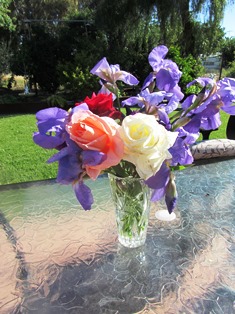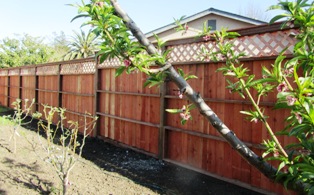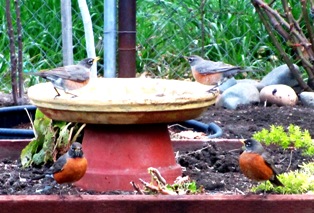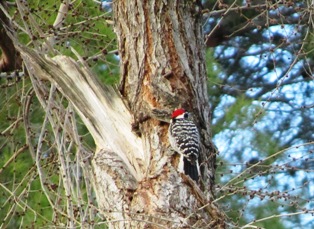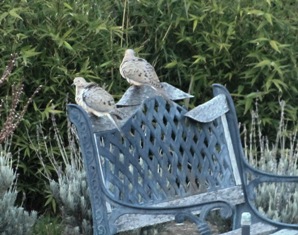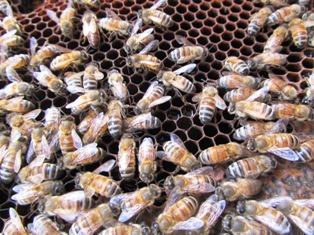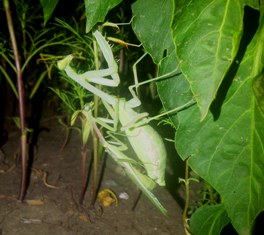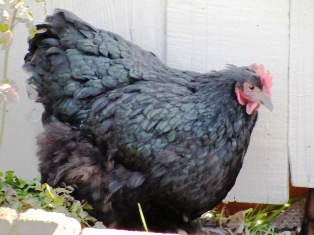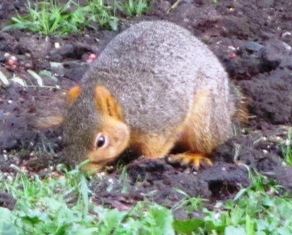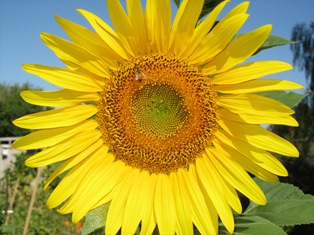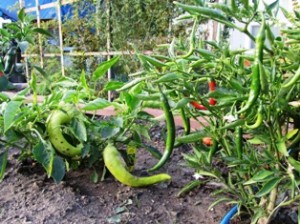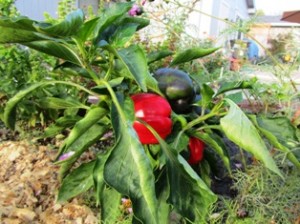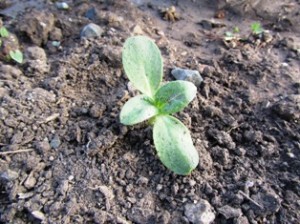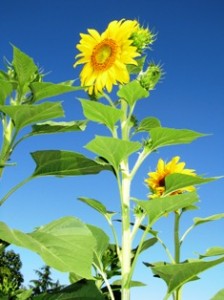Archive for the 'Animals' Category
Remind Me Again, What Good Are Gophers?
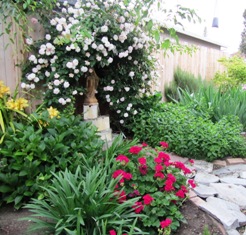
Cecile Brunner forms an arch over a statue of the Virgin Mary in one of the prettiest and most peaceful areas of my garden
The lovely Cecile Brunner rose that serves as the anchor for a small meditation garden on the northwest side of my little farmhouse suddenly appears yellowed, leafless, and lifeless. Honest to goodness, she looks like she’s croaked. It’s certainly a strange turn of events, since she had numerous new canes and the leaves were shiny and healthy only a week ago.
There is a small eruption of new dirt nearby–suggestive of moles (insect eaters) and gophers (vegetarians) and maybe voles–(voles eat roots but don’t leave mounds). So my rose problem might actually be two-fold–either way–it’s underground.
I could dig and back fill those tunnels with dirt and maybe I should. I’ve heard you can break a leg stepping into a gopher hole and I’m not talking livestock here. I wonder if the vole and gopher are sharing a network of tunnels down there dead-ending in the gopher’s bunker.
I gave the poor rose a big drink of water as soon as I discovered her condition, not knowing what else to do. As I stood there, watering with hose in hand, I saw the earth around the rose’s root cave in. Seriously?
So I’m thinking there must be a one heck of a big tunnel. This is war! I decide to stick the hose right into the tunnel and fill it with as much water as that hole will hold . . . and then some.
Strangely, while I’m dealing with the rose problem, I look past the fresh dirt mound and notice that one of the Dutch purple irises in a bed of a hundred or more has broken into full bloom. What gives? Those beauties normally bloom around Easter. I wonder why the voles haven’t attacked the rhizomes of the irises.
The condition of the Cecile Brunner climbing rose breaks my heart. Maybe she’ll spring back to life to bloom again next spring. For now, I’ll clip the beautiful iris and tuck it into a vase with some roses from other bushes on the farmette. That done, I’ll put an all-out effort into finding out how to get rid of those underground buck-tooth bandits . . . for good. Feel free to leave me your ideas. I’ve tried almost everything I’ve read on the Internet.
Those Entertaining Rascals, the Sparrows
I enjoy watching the sunrise over the hills that jut up between the inland valley of the East Bay, where I live, and the waters of the delta flowing down from Sacramento to dump into the Straits of Carquinez before entering the San Francisco Bay. A lot goes on in our backyard garden at sunrise.
With feeders filled with birdseed, all sorts of songbirds visit to eat before bathing in the bird bath perched in a raised bed of blooming geraniums, asparagus ferns, and foxglove flowers. The squirrels search feeders for sunflower seeds. And clusters of house sparrows twitter away as they forage for seeds, insects and other interesting morsels to devour.
These cutie pies descend to the lawn as soon as the sun is up. They bathe, drink, and eat, often stealing food from other birds. A robin with a beak full of worms better take heed of the presence of sparrows or those little cheep, cheep, cheepers will steal the food right out of the robin’s beak.
The sparrow’s thievery isn’t limited to food; no, it will also steal nesting material from each other’s nest. But these scrappy little fellows will just as readily engage in their birdbrain version of fisticuffs as they will dart into trees for cover.
Without a doubt, of all the birds that are visiting the garden of late, the sparrows provide hours of entertainment.
Choosing the Milk for the Cheese …Goat or Cow?
Imagine the taste on your palate of warm figs with a dollop of goat cheese right off the grill, accompanied by a lovely California red wine. Now re-imagine that cheese produced by your own goat. This is my new dream.
For me, the taste of cheese and yogurt produced from goat’s milk is preferable to the taste of the same products made from cow’s milk. Lately, I’ve been considering the pros and cons of owning a goat versus a cow.
My list goes something like this:
Goat:
Smaller (easier to transport, shelter, and handle)
Eats less feed, therefore costs less to keep
Produces less milk (which is an advantage when your family is small and doesn’t drink much milk)
Goat manure is dry (arrives on the ground in pellet form)
Goats are great foragers and keep weeds and grasses nibbled away
Cow:
Bigger (needs larger shelter and transportation)
Eats more, drinks more, therefore costs more to keep
Produces more milk than goats
Cow manure is wet (turns into dry “pies”)
Cows need pasture and feed (cows eat roughly ten times as much as a goat)
I’m thinking I’d need a farm to own a cow; but for my little farmette, a goat makes more sense. As for choosing the type of goat; well, that’s another process. For now, I think I’ll pick some summer figs and melt a little goat cheese on top. Wine anyone?
Tortoise Alert
We have been working like crazy the last few days, busily applying the finishing touches to the redwood fence we are building for our neighbors. We are pushing because they have scheduled a party on Saturday to celebrate the birthday of the youngest member of their family. He turns one year old.
Around noon, above the cacophony of hammers pounding and saws buzzing, we hear our neighbor’s voice call out, “Has anybody seen the turtle?” He was referring to the family pet, an African Spur Thigh Tortoise, who’d taken off from his designated area of the yard and was no where to be found.
We dropped our saws, laid down our hammers, and started searching the three yards that conjoined at a certain point along the fence lines. We looked under the recently raised shed and searched the perimeter of two neighbor’s yards until finally a voice called out, “Found him.”
The pet tortoise had moseyed over to the kids’ play area and had found a shady spot to its liking. There it seemed to be enjoying itself, hanging out, without the concern that its absence was causing its owner.
After a few minutes, Carlos and I and our worker, Alejandro, resumed our tasks. After all, the fence had to be finished. The party was less than 24 hours away.
I had to wonder why the tortoise felt the need to find shade. Its species is at home in the hottest, driest, desert type places on earth, for example, in Northern Africa: Senegal, Niger, Chad, Ethiopia, and The Sudan. But maybe it wasn’t the sunshine it was seeking to escape but rather the noise. I guess we were making quite a racket with our hammers, saws, and shovels.
Springtime Serenades from the Garden
The robins have arrived on the farmette. I’ve been moving dirt with the help of my husband and a worker and there are worms galore. If there’s anything a robin delights in more than dining on a fat, pink worm it surely is singing.
Throughout the morning, I hear its song–cheerily cheerily cheerily as it throws back its head and stands at attention in its red vest and gray-colored waistcoat.
The robin is one reason why I don’t believe in using insecticides for trees and lawns. Rains wash these contaminants into the soil, the earthworms eat the contaminated dirt, and the robins eat the worms. The cycle can be fatal for the birds.
High in an old elm tree with broken limbs and rot in places, a Nuttall’s Woodpecker adds its course drill of pr-r-r-r-rip to the robin’s song. What the woodpecker lacks in beautiful song, it more than makes up in its appearance. This fellow has a black-and-white striped face and back and a bar of black around its eye. Its cap is a vibrant splash of red.
These birds dine on insects from tree bark and frequently build their nests in a dead limb. Their clutch of white eggs hatch in about 14 days and the male shares responsibility with the female in incubating the eggs.
So while the work of moving dirt (so far, digging down to the septic to inspect and reinforce it and moving a section of dirt to the garden to replace an old gravel driveway) is tedious and time-consuming, the serenades of birds in the garden make the effort a bit more tolerable.
A Whole Lot of Coupling Going On
Lately, the way the birds, insects, and wild creatures are pairing up, you’d think we were on Noah’s Ark instead of the Henny Penny Farmette.
I’ve never seen such bird and bee traffic as in the last few days. This morning, I put on the bee suit and joined my neighbor on a tour of inspection to see if the bees survived the cold snap we had a week or so ago. We had snow on Mount Diablo and a hard frost elsewhere. But the bees are fine, and there are lots of babies.
Today, the yellow finches are congregating around the Nyjer feeder and singing their little hearts out. There’s a woodpecker in the neighborhood (maybe two). I haven’t seen it/them but there’s a whole lot of tap-tap-tapping in the nearby oak trees.
I often see a flash of blue as I work to move and amend the soil on our property. Last year about this time, pair of Western blue birds were scouting locations for a nest. They are back and I hope they stick around.
The plaintive coo-coo-coo of the mourning doves has become a chorus of late. At first, I noticed a pair in the back yard and now there are several pairs. They mate for life. So we’ve put out birdseed and I fully expect to see a nest or two being constructed in the next few weeks.
Birds and bees are either producing young or making preparations to produce offspring. But the praying mantises? Who knew?
So what I’m taking from all this pairing up is that Mother Nature expects warm days ahead. The wild creatures made it through the winter. No one has to tell them what to do now that spring is only weeks away. Like I said, it looks like Noah’s Ark around here.
Plants for a Songbird Garden
If you enjoy songbirds as I do, you might want to plant a garden of flower and herb varieties to attract them.
Include in your songbird garden some perennials and annual plants. The perennials will re-seed themselves or return year after year. Commercial seed companies offer a pre-packaged collection of seeds, but you can also gather your seeds or plants from other sources such as friends, neighbors, and garden club members. I save the seed from many of my plants, dry them, and use them for planting the next year.
Plants might include (but are not limited to) Alcea rosea (common hollyhock, comes in many colors), Amaranthus caudatus (commonly known as love-lies-bleeding), Carthamus tinctoria (safflower seed), coreopsis (tickseed), Cosmos bipinnatas (old flower garden favorite), Delphinium ajacus (blue or purple larkspur), Echinacea purpurea (eastern purple coneflower), Eschscholzia California (California poppy), Guizotia abyssinica (Nyjer seed, often called thistle although it isn’t thistle by an oily seed loved by finches), Panicum miliaceum (common millet), Papaver rhoeas (opium poppy, some types can be as tall as seven feet), and Rudbeckia hirta (Black-eyed Susan).
The heights of these various plants range from about 15 inches to six or seven feet. The colors are varied, ranging from whites to pink, red, orange, yellow, green, and blue.
The types of songbirds these plants will attract include cardinals, finches, goldfinches, hummingbirds, mockingbirds, warblers, chickadees, wrens, titmice, and thrushes.
Missing My Chickens
My next door neighbor welcomed us to the neighborhood when we bought the Henny Penny Farmette. He gave us produce from his garden, honey from his hives, eggs, and even the chickens that laid them. We didn’t even have a chicken house back then.
That didn’t stop us. It was summer, I was married to an architect/builder, and we put “build a chicken house” on our list of things to do.
It took about a week to build out the chicken house. The best time to transport chickens are at night when they are calm. You go into their old roost after dark and carry them to their new dwelling.That way, they awaken at dawn in their new home, and the move is a fait accompli.
After the six laying hens moved in, I named them. The white one seemed especially flighty so she became flighty Tighty Whitey. There were two brown hens, Click and Clack; two Mediterranean hens, Henrietta and Heloise; and Mystery, the large black Cochin, who wouldn’t lay many eggs but loves to sit on them.
Since my neighbor believes that every hen house needs a rooster, he brought over a cute little whipper snapper that I named Houdini. What Houdini lacked in height and weight (he was after all a Bantam), he made up for in attitude.
Carlos outdid himself building that chicken house. He insulated it, tiled the floor, put in nesting boxes all along one wall (with little windows that could be opened so you could reach in to gather eggs), and a red thermal light for heat.
One day, inspectors from the city came out to look for standing water before mosquito season began and spotted the spiffy new chicken house. One fellow joked, “If those chickens don’t like it, call me. I’m looking for a new place.”
I grew attached to the chickens; so much so that when I lost two because of prolapsed cloaca, I mourned them as if family members had passed. Then last year, each time I cleaned the chicken house I suffered an asthma attack. This occurred in spite of wearing a mask the entire time I cleaned it. The chickens needed a clean house, but I could no longer be the cleaning lady.
I could not find takers for that job, so with a heavy heart I decided to give my chickens to a Lebanese lady. She wanted the chickens and had family members who would help her take good care of the brood. All the chickens except Mystery moved to the lady’s chicken house. Mystery moved back into the coop next door.
I miss the contented clucking of the chickens as they scratched their way around my yard. I miss Houdini’s gravely cockle-doodle-doo that awakened me before dawn. And I miss the fresh eggs that I would happily gather each morning from the splendid chicken house that Carlos built.
I’m fortunate that my neighbor kindly supplies me with organic eggs from his chickens. When I really get to missing the chickens, I popped over the fence to visit Mystery. Maybe she misses me, too. When I call her name she still answers.
Lately, I’ve been thinking about building a new chicken house with room for one or two chickens. I’d like to be able to move it around the yard on wheels. It would have to be tall enough to contain a roost and it would have to accommodate a nesting box or two, and include a wired section like a big box that could be detached. The whole thing wouldn’t need much cleaning. So, now I I’m trying to find the right time to broach the subject with my architect in residence.
Serve Up Seeds for Furry and Feathered Creatures
Squirrels can contort their bodies into bizarre and exotic positions just to get at the seeds in a bird feeder, as any wildlife watcher can tell you. But they aren’t crazy about all birdseed. Safflower is a good example of a seed loved by birds but not squirrels. The squirrels will forgo a whole feeder of that seed in order to dine on sunflower hearts that is also a favorite of chickadees, finches, and woodpeckers. Pesky squirrels will also paw through a bird feeder to eat other seeds mixed into a commercial wild bird feed but still pass on eating the safflower if it is present.
Since both squirrels and many species of wild birds love sunflower seeds, we grow several types throughout the summer. When fall approaches, we place the dried heads of the sunflowers in an area away from a bird feeder to attract the squirrels and hopefully limit their foraging of food intended for the feathered wildlife. Sometimes it works. However, mourning doves are ground feeders and so are quail. We’ve found the squirrels and the birds foraging together for sunflower seeds.
A squirrel and mourning dove share a meal
The finches enjoy the black Nyger (or thistle) seeds so we keep one feeder of that seed just for them. We love the splashes of yellow (the coloring of their breasts) as they flit around and perch on the feeder to devour their favorite meal. But other birds with small bills like the California quail, pine siskins, towhees, dark-eyed juncos, song sparrows, and purple finches also are attracted by Nyger seeds and will dine often if the feeders are kept filled.
Squirrels and some types of birds particularly enjoy pumpkin seeds and peanuts, so we also put those out when the weather becomes bleak and we’re pretty certain that the wildlife around us isn’t finding much food. During those periods, we also hang suet for the birds, especially those that hang around for the winter but don’t have a lot of food choices such as crows, robins, and the American goldfinches.
When you ensure adequate food supply for the furry and feathered creatures in your backyard, you will be rewarded with many entertaining and heart-warming images. Keep your camera handy for capturing squirrel contortions or surprising pictures of who dines with whom.
Lots of Peppers and Sunflowers Hanging Around
My pepper plants are still producing. It’s a week before Thanksgiving and by this time last year I had harvested all the warm season crops like the peppers. But the plants still have many peppers hanging and are still blooming.
I even have a tomato plant that’s got blooms on it. Of course, most old timer gardeners will tell you that tomatoes won’t set fruit if night-time temperatures aren’t 55 degrees Fahrenheit or higher. So I’ll wait for another week or two to figure out whether or not to pull out the tomato and harvest the peppers. I can use the sweet bells in my Thanksgiving dinner prep.
Yesterday, I laid out on a small stone floor a giant sunflower head that had already dried. The birds, and especially the squirrels, love the seeds. The squirrels practically replant them for me all over the property. The giant sunflower heads laden with seed are my gifts to the wildlife each autumn.
There are sunflowers and then there are the giants that stand seven or eight feet tall with heads the size of dinner plates. The stalks are as thick as the diameter of a coffee mug. It usually takes me a few hours of working with a pick axe to dig out all the stalks and compost them.
I save the seeds from the giants so I can let them dry over the winter and plant again the next year. I’m just guessing but I’ll bet from all the seed heads I’ve saved, I’ve got thousands of seeds. Maybe I’ll package up 50 or so to a bag and give them away at Christmas or sell them at the farmer’s market when it starts up again next year. For now, I’ve got my sights set on making some pepper relish for Christmas season gift baskets of food.
 Facebook
Facebook Goodreads
Goodreads LinkedIn
LinkedIn Meera Lester
Meera Lester Twitter
Twitter





